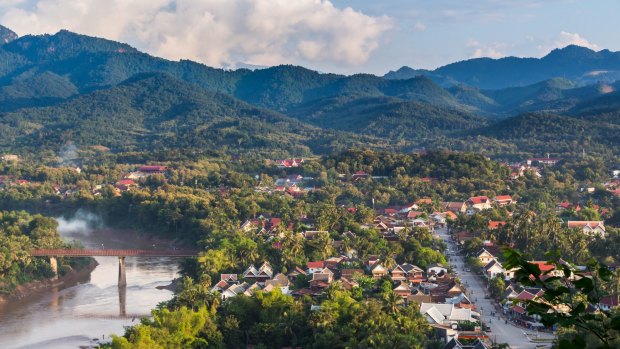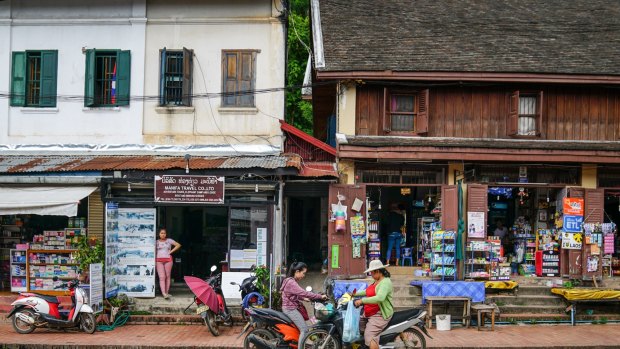This was published 6 years ago
Luang Prabang, Laos: City of Gold with a French connection

Luang Prabang, Laos.Credit: Shutterstock
It's early morning in the UNESCO World Heritage-listed city of Luang Prabang yet the sun bears down vehemently as if attempting to melt the gilt edges off its centuries-old temples. Tuk tuks whizz by as we step from the Avani+Luang Prabang, a boutique hotel housed in an historic building dating back to 1914.
The saffron-robed monks who shuffle through the city at dawn have, sensibly, long since departed. Locals and bleary-eyed tourists lined the streets before sunrise handing out alms to the solemn monks with their shaven heads. Kneeling on straw mats we placed balls of sticky rice, prepared in the wee hours of the morning in the Avani kitchen, into the monk's begging bowls. Once the last monk had filed by, my 10-year-old daughter, Ella, stuffed a ball of rice into her mouth, telling me she'd now eaten breakfast too.
Mere steps from the Mekong and Nam Khan rivers, in the former ancient Laos capital, the Avani with its contemporary French neo-classical architecture was formerly the French officer quarters. It's here we meet our guide for a heritage walking tour of this charming preserved city.

Soak up the colour, sights and sounds of Luang Prabang.Credit: Shutterstock
First stop is the morning market where locals have spread their wares across tables and mats on the ground. There are tubs of squirming eels, vegetables and herbs of every persuasion, sacks of bright orange marigolds, black rice, crickets and dried fish. Ella begs me to buy a turtle and release it back to the fast-flowing river. Our softly spoken guide gently steers her away, explaining that if she buys it the locals will only catch it again and resell.
Luang Prabang was once known as the City of Gold (Muang Xieng Thong).
It's a fusion of temples, French colonial villas and traditional Laos homes on stilts, many of which have been given a new lease of life since its UNESCO status was granted in 1995. From the market our guide takes us to the Royal Palace Museum. Built by the French in 1904 for the royal family with an elegant stupa-like spire, it's a tasteful meld of European and Lao design. Our guide points out the pediment over the entrance, a gilt rendition of the symbol of the Lao monarchy Airavata, the three-headed elephant, surrounded by the 15 guardian naga of Luang Prabang. "Laos is known as the land of a million elephants, an animal symbolising power and once used in battle, religious ceremonies and for transport," he explains.
From there we visit Wat Xieng Thong. Built in the 16th century, it's the most important and impressive Buddhist temple of the 30 wats found in the city. The low sweeping double-tiered roof and elaborate interior and exterior decoration are one of the best examples of the characteristic Luang Prabang style.
Wending down narrow streets lined with crumbling colonial villas, we pass family run guesthouses, chic bars and restaurants. We're fading fast, so our guide suggests one last stop at Heuanchanh Heritage House, a century-old traditional Laos house that is now a museum and cafe. After a look through the beautifully preserved home, we take a seat on a shady deck. We guzzle iced lime and soda, parched by our walk in the heat of the day.
Returning to the Avani we pass the rear of Wat Xieng Thong where a group of novice monks are noisily clashing cymbals and banging an enormous temple drum. We stop to soak up the colour, sights and sounds of this magical city on the mighty Mekong.
TRIP NOTES
Sheriden Rhodes was a guest of Avani Hotels and Resorts.
MORE
avanihotels.com/en/luang-prabang
STAY + DO
The Avani+Luang Prabang offers stylish rooms from $242 per night including breakfast. The three-hour heritage walking tour costs $US98 for two people including entrance fees and English-speaking guide. Shoulders and knees need to be covered if entering temples.
FLY
Singapore Airlines flies to Luang Prabang from Sydney and Canberra via Singapore with connections with Silkair. singaporeair.com
Sign up for the Traveller Deals newsletter
Get exclusive travel deals delivered straight to your inbox. Sign up now.